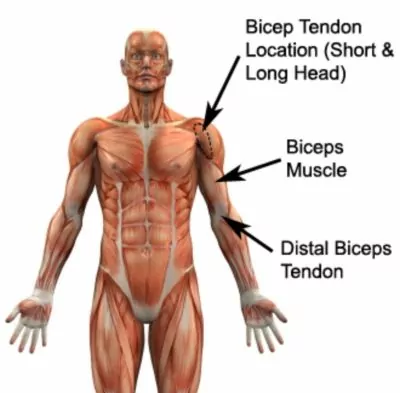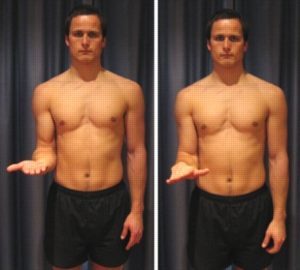Biceps Tendon Rupture
Updated:
(Also known as Biceps Rupture, Ruptured Biceps)
What is a biceps tendon rupture?
A biceps tendon rupture is a condition characterized by complete tearing of one or more tendons of the biceps muscle.
The muscle at the front of the upper arm is known as the biceps. The biceps originates from the front of the shoulder blade (attaching here via the short and long head of biceps) and inserts into the forearm via the distal biceps tendon (figure 1). The biceps has two muscle bellies known as the short and long head of biceps.

During contraction of the biceps, tension is placed through the biceps muscle and tendons. When this tension is excessive due to too much repetition or high force, damage to the biceps tendons may occur. Occasionally, this may cause the biceps tendon to rupture. When this occurs, the condition is known as a biceps tendon rupture.
Biceps tendon ruptures are more common in the older patient with a history of biceps injury or tendonitis. The long head of biceps tendon is by far the most commonly ruptured biceps tendon.
Causes of a biceps tendon rupture
A biceps tendon rupture most commonly occurs due to sudden or excessive contraction of the biceps muscle. This may occur when bending of the elbow forcefully against resistance (such as performing chin ups or biceps curls), during heavy lifting (particularly overhead) or forceful arm elevation activities. Occasionally a biceps rupture may occur due to gradual trauma associated with repetitive or prolonged activities placing strain on the biceps tendon. This may weaken the biceps tendon, predisposing it to a complete tear with minimal trauma. Biceps tendon ruptures are relatively common in weight lifting or sports requiring forceful use of the upper limb and biceps.
Signs and symptoms of a biceps tendon rupture
Patients with a biceps tendon rupture typically experience a sudden onset of pain in the front of the elbow, shoulder or upper arm. This is usually associated with a sudden snapping or tearing sensation. Symptoms may settle quickly leaving the patient with an ache that is particularly prominent at night or first thing in the morning. Sometimes, there may be little or no pain. Obvious deformity of the biceps muscle is usually noted especially when compared to the non-injured side. This may become more obvious during contraction of the biceps muscle. The deformity appears as a bunching of the biceps muscle in the lower part of the upper arm.
Stiffness, swelling and bruising may also be present and may become more prominent the next morning and over the coming days. Weakness of the elbow or shoulder is another common feature that may be particularly prominent when bending the elbow against resistance, during lifting or elevation activities. Many patients with a long head of biceps tendon rupture, however, maintain the majority of their biceps and shoulder strength.
Diagnosis of a biceps tendon rupture
A thorough subjective and objective examination from a physiotherapist is usually sufficient to diagnose a biceps tendon rupture. Further investigations such as an Ultrasound, X-ray or MRI are often required to confirm diagnosis and rule out other injuries.
Prognosis of a biceps tendon rupture
Most patients with a long head of biceps tendon rupture heal well with appropriate physiotherapy and return to relatively normal function in a number of weeks. Since the ruptured biceps tendon does not repair on its own some weakness may persist although this is usually minimal.
Patients seeking the highest level of function (such as power sport athletes) or those with a ruptured distal biceps tendon may require surgical intervention to ensure an optimal outcome and a lengthy rehabilitation period to follow, lasting many months. In these surgical cases, early intervention tends to be better than delayed intervention, as the biceps muscle can retract and scar over time, making it difficult to surgically reattach the tendon.
Treatment for a biceps tendon rupture
For those patients with a distal biceps tendon rupture, treatment typically involves surgery to reattach the biceps tendon. This is usually followed by a period of rest to protect the repair and rehabilitation under guidance of the surgeon and treating physiotherapist.
Patients with a long or short head of biceps tendon rupture seeking the highest level of function (e.g. some athletes) may also undergo surgery to repair the ruptured tendon. Most patients, however, have a very good outcome with conservative measures and appropriate rehabilitation under physiotherapy guidance.
The success rate of treatment for a biceps tendon rupture is largely dictated by patient compliance. One of the key components of treatment is that the patient rests from any activity that increases their pain until they are symptom free. This allows the body to begin the healing process in the absence of further tissue damage. Once the patient can perform these activities pain free, a gradual return to these activities is indicated provided there is no increase in symptoms.
Ignoring symptoms or adopting a ‘no pain, no gain’ attitude is likely to lead to further damage and a prolonged recovery. Immediate, appropriate treatment in patients with a biceps tendon rupture is essential to ensure a speedy recovery.
Patients with a biceps tendon rupture should follow the R.I.C.E. Regime in the initial phase of injury. The R.I.C.E regime is beneficial in the first 72 hours following injury or when inflammatory signs are present (i.e. morning pain or pain with rest). The R.I.C.E. regime involves resting from aggravating activities, regular icing, the use of a compression bandage and keeping the arm elevated (provided this is comfortable). Anti-inflammatory medication may also significantly hasten the healing process by reducing the pain and swelling associated with inflammation.
Patients with a biceps tendon rupture should undergo a graduated flexibility and strengthening program to ensure an optimal outcome. This can usually commence once the orthopedic specialist and physiotherapist have indicated it is safe to do so. The treating physiotherapist can advise which exercises are most appropriate for the patient and when they should be commenced.
Manual “hands-on” therapy from the physiotherapist such as massage, joint mobilization, dry needling, stretches and electrotherapy can also assist with improving range of movement and function following a biceps tendon rupture. This can generally commence once the orthopaedic specialist or physiotherapist has indicated it is safe to do so.
In the final stages of rehabilitation, a gradual return to activity or sport can occur as guided by the treating physiotherapist provided there is no increase in symptoms.
Contributing factors to the development of a biceps tendon rupture
There are several factors which can predispose patients to developing a biceps tendon rupture. These need to be assessed and corrected with direction from a physiotherapist. Some of these factors include:
- joint stiffness (particularly the elbow or shoulder)
- muscle tightness (particularly the biceps or triceps)
- inappropriate or excessive training
- inadequate warm up
- muscle weakness
- history of a biceps injury or tendonitis
- inadequate rehabilitation following a previous biceps injury
- poor posture
Physiotherapy for a biceps tendon rupture
Physiotherapy treatment for a biceps tendon rupture is vital to hasten the healing process, ensure an optimal outcome and reduce the likelihood of future injury. Treatment may comprise:
- soft tissue massage
- electrotherapy (e.g. ultrasound)
- dry needling
- stretches
- joint mobilization
- ice or heat treatment
- exercises to improve strength, posture and flexibility
- education
- anti-inflammatory advice
- activity modification advice
- a gradual return to activity program
Other intervention for a biceps tendon rupture
Despite appropriate physiotherapy management, some patients with a biceps tendon rupture do not improve adequately. When this occurs the treating physiotherapist or doctor will advise on the best course of management. This may include further investigations such as X-rays, ultrasound, MRI or CT scan, pharmaceutical intervention, corticosteroid injection or referral to appropriate medical authorities such as an orthopedic specialist who will advise on any intervention that may be appropriate to improve the condition.
Exercises for a biceps tendon rupture
The following exercises are commonly prescribed to patients with a biceps tendon rupture. You should discuss the suitability of these exercises with your physiotherapist prior to beginning them. These can usually begin once the orthopedic specialist or physiotherapist have indicated it is safe to do so. Generally, they should be performed 2 – 3 times daily and only provided they do not cause or increase symptoms.
Elbow Bend to Straighten
Bend and straighten your elbow as far as possible and comfortable pain-free. Aim for no more than a mild to moderate stretch. Repeat 10 times provided there is no increase in symptoms (figure 2).

Elbow Supination Pronation
Begin with your elbow at your side and bent to 90 degrees. Turn your palm up and down as far as possible and comfortable pain-free. Aim for no more than a mild to moderate stretch. Repeat 10 times provided there is no increase in symptoms (figure 3).

Static Biceps Contraction
Begin this exercise with your elbow at your side and bent to 90 degrees, palm up as demonstrated (figure 4). Push up against your other hand, tightening your biceps. Hold for 5 seconds and repeat 10 times as hard as possible without pain.

Physiotherapy products for a biceps tendon rupture
Some of the most commonly recommended products by physiotherapists to hasten healing and speed recovery in patients with a biceps tendon rupture include:
To purchase physiotherapy products for a biceps tendon rupture click on one of the above links or visit the PhysioAdvisor Shop.
Other Exercises
- View more Biceps Flexibility Exercises.
- View more Biceps Strengthening Exercises.
Find a Physio for a biceps tendon rupture
Find a physiotherapist in your local area who can treat a biceps tendon rupture.

Link to this Page
If you would like to link to this article on your website, simply copy the code below and add it to your page:
<a href="https://physioadvisor.com.au/injuries/elbow-forearm/biceps-tendon-rupture”>Biceps Tendon Rupture – PhysioAdvisor.com</a><br/>PhysioAdvisor offers detailed physiotherapy information on biceps tendon rupture including: signs and symptoms, causes, diagnosis, treatment, exercises, physiotherapy products and more...
Return to the top of Biceps Tendon Rupture.




